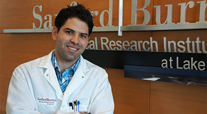This interview with Lake Nona postdoctoral research associate Juan Pablo Palavicini, PhD, is the second installment in our “Meet our Postdocs” Beaker series. Juan Pablo works in the laboratory of Xianlin Han, PhD, which focuses on altered lipid metabolism, trafficking and homeostasis under patho(physio)logical conditions.
Tell us a little bit about yourself – where are you from and why did you move to Orlando? I was born in Costa Rica into a fantastic and wonderful family, where I received tons of love and great values. Both of my parents are doctors, my dad Carlos is an orthopedic surgeon, and my mom Giselle is a retired rehabilitation physiatrist. They gave me, as well as my older brother and my younger sister, all the tools we needed to follow our dreams. At the end of my PhD, I got married to a gorgeous Costa Rican girl, Cinthia, who never thought about leaving our beautiful country. Therefore, I had to find a fantastic place she couldn’t resist, and Orlando was the answer.
What made you come to Sanford-Burnham? I read about Orlando’s desire to build a strong bioscience hub in an airline magazine and Sanford-Burnham was mentioned in the article, too. The Institute was depicted as one of the most successful and renowned nonprofit research organizations in the U.S. and the world. Later, after searching for more information on the Web, I found the Lake Nona Medical City website, and I was impressed by the plans and vision. A few months later, I had the opportunity to visit the Medical City during a family visit to Orlando. I really liked it, and I searched for a research group that worked on Alzheimer’s disease. My wife couldn’t resist the idea of living next to Orlando’s top-class attractions and we decided to become part of the Sanford-Burnham family.
Tell us about your research. What is it that you do all day in the lab? I am a neuroscientist and I study the molecular intricacies that occur inside the brain that lead to Alzheimer’s disease. I work with animal models, mice in particular that have been genetically modified to develop the pathological features characteristic of this common form of dementia. We use a variety of biochemical, molecular biology, and histological approaches to better understand which molecules are affected by this devastating disease. Our laboratory has a particular focus on lipids, which are very abundant in brain tissue. Interestingly, we have found one specific lipid type that is specifically and extensively decreased during Alzheimer’s pathogenesis. In addition, I am also studying potential molecular links that could explain why diabetes is a high-risk factor for developing dementia later in life.
Why did you pick this particular research area? I have been absolutely astonished by the vast and extremely complex world inside a cell ever since I started learning about them in school. The more I learned about this magnificent and elaborate world, the more I wanted to find out about it. The brain is the most complex and amazing system in the universe and I decided I wanted to spend the rest of my life studying it. Alzheimer’s disease is the most common form of dementia; studying it offers me the opportunity to learn more about the brain and, at the same time, generate new knowledge that will hopefully help Alzheimer’s patients in the future.
Do you have any advice for postdocs who would like to apply for a position at Sanford-Burnham? I would definitively encourage any graduate student or current postdoc to apply for a position at Sanford-Burnham. We have a tremendous group of scientists who are highly collaborative and successful. In addition, we have a wonderful Office of Training & Academic Services, which offers valuable courses and workshops to enrich our postdoctoral experience. I also encourage potential postdocs to make sure they really love and enjoy doing science before starting a postdoctoral position, because if you don’t, then you shouldn’t.
What do you do in your free time? Any exciting hobbies or interests? I have always loved sports. When I was in school I used to bowl. I took it seriously and after a lot of practice, I became Costa Rican youth champion. Later, when I went to college, I decided I wanted to do something more cardio, so I tried boxing classes. I loved it and spent a couple of years training every other day until my coach said I was ready to compete at an amateur level. A little while after my first boxing match, which I won by technical KO, I left Costa Rica and, luckily for my brain, I decided to switch sports again, this time I jumped into soccer. During my time as a PhD student at the University of Puerto Rico, I joined the second-division Guaynabo City soccer team. After my first season there as a goalie, my coach recommended me for the first-division team, where I started training every day shortly after graduating. I decided to leave Puerto Rico to pursue my postdoctoral research in Florida, where I switched sports again. This time, my teammates are my wife and our 2-year-old daughter Mia, and we do Disney park “racewalking!”
